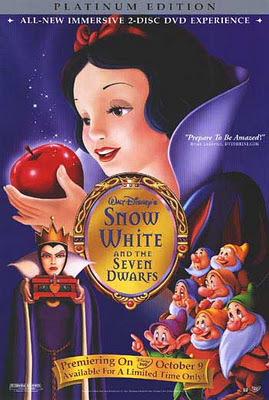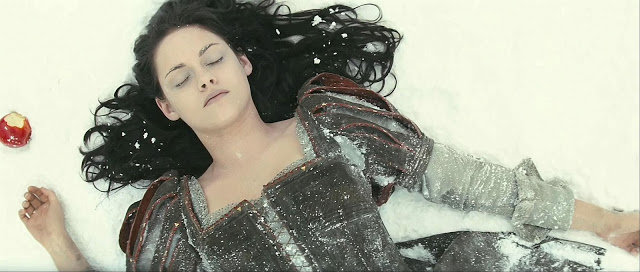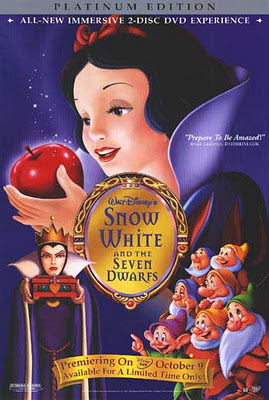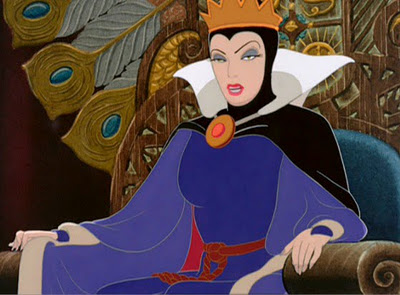 |
| Maleficent appears at King Stefan’s castle |
 |
| “A thunderbolt! To mix it well. Now…begin thy magic spell.” |
- Otherwise known as the Wicked Queen or The Witch, she is, of course, the very first villain in the Disney canon. And by god, is she memorable. Her face has a cold beauty enveloped in a dark headdress and a billowing violet cape. She is notably vain, but who can blame her? The Queen cannot be more than 40something at the most, and yet the Dwarfs, who must be positively ancient, refer to her as the “Old Queen.” Old? OLD? Not a wrinkle on her face and yet a group of dumpy, tiny old men consider her old. To hell with that. It’s quite obvious she lives in a world not so different from our own. A world where the only kind of beauty that is valued is the youthful kind. She fears the encroaching inevitability that one day her looks will fade, and then all that she has worked for–respect, power–will vanish and be transferred to her preteen stepdaughter. Her husband, the King, is noticeably absent, meaning that she is probably a regent. Her power is temporary, just like her beauty. The real tragedy of her death is that she has left her kingdom without a ruler. Snow White’s scampered off to go be with her Prince, and obviously doesn’t care about her birthright.
- The Dwarfs speak of her talents with black magic. This is a brilliant woman. Deliciously bloodthirsty. The skeleton in her dungeon shows that she has killed before. This is not a woman to be trifled with. Her dungeon is full of books, tomes, instruments, and devices. In another world she would have been a scientific genius. As the Witch, she is an enormously quick thinker, and a rather effective actress. It is impossible for her to completely hide her malice towards Snow White, and yet see how ingeniously she tricks her into eating that poisoned apple. Note how she checked for an antidote to the poisoned apple, a sign of tremendous genre savvy. How was she to know that the Dwarfs would display Snow White’s body above ground as if she was some sort of attraction? Appreciate her enormous amount of power. How she could distill fear into liquid. How she could command the winds and lightning itself. Such a powerful, commanding woman. What a wonderful precedent she set.
 |
| Lady Tremaine figures out that Cinderella was the woman at the ball |
- Another early villainess and Wicked Stepmother whose name is underused (she is only referred to as Lady Tremaine at the ball when her daughters are being introduced). Cold green eyes and meticulously neat grey hair are the most recognizable features of a woman who is not to be trifled with. She has a dangerously quick, brilliant mind, and considering she named her horrible cat after the devil himself, apparently a sense of humour as well. The narrator tells us that she and her daughters are bitterly jealous of Cinderella. Can we really blame them? The daughters are plain, but hardly hideous, and yet the Prince and Duke act like they’re the ugliest women they’ve ever seen. The Prince actually rolls his eyes at them, an incredibly rude act considering that all he knows of them is that they came when summoned to the ball. The Duke shudders when Anastasia tries to show polite deference to him. Asshole. These two men are powerful, so Lady Tremaine has no choice but to be ambitious and try every opportunity possible to get her daughters to a higher station. She’d naturally be jealous of the stepdaughter who will get ahead mostly on the strength of her looks. As for the scene when the daughters rip apart Cinderella’s dress, although they tremendously overreacted, she IS wearing stolen jewelry and fabric. Is the movie seriously trying to tell me that after years of doing their laundry, Cinderella can’t recognize her own stepsisters’ belongings, and didn’t question where the mice got the materials to make the dress with? Come on now. And as for Lucifer, Disney, you are not going to convince me that a cat is evil just because he hunts house mice. I mean, how DARE a cat act according to its biology! Mice are destructive, noisy, disease ridden pests, and their talking and singing in this film has still never endeared me to them. Cat lover for life here.
- Lady Tremaine herself is an amazingly effective villainess. The first of two Disney villains voiced by Eleanor Audley (who has to be one of the all-time greatest voice actors), I really love watching her brilliant mind work out details, and how quickly she reacts to things. I love the scene where she tells her daughters to control their tempers, and then immediately loses her own temper when she is interrupted by Cinderella. Her eyes are penetrating, and when she walks upstairs to lock Cinderella in her room, you follow her eyes the entire time. Her satisfied smirk when she believes she has succeeded over Little Miss Perfect. I also rather enjoy the touch of sarcasm and spite hidden in faux-affection when she refers to the clearly adult Cinderella as “Child.” Ah, if only all the Wicked Stepmothers in the innumerable adaptations of Cinderella were half as much fun as Lady Tremaine is.
 |
| “Now shall you deal with ME, O Prince. And all the powers of HELL!” |
- I’m going to go out on a limb here and say that Maleficent has got to be Disney’s most popular villain, and probably one of their most popular characters, period. When I asked for nominations of favourite Disney villainess, her name came up more often than anyone else’s. And I absolutely love the hell (pun intended) out of her myself. Her iconic design, combining the horns of Chernabog (the Devil in Fantasia) with a purple and green motif, defines the ultimate Disney villainess. Her infinite power is fascinating to watch. She can make a castle shake and blow hurricane-like winds even before she’s entered the room. Character-wise, like Lady Tremaine, she also has a sick sense of humour. Her curse on Aurora isn’t out of jealousy (let’s not pretend she really gives a shit about whether she was invited to the christening or not) but just because she can. She even kills the Three Fairies’ flowers with frost for the fun of it. And, upon learning that her moronic followers had been searching for a baby for sixteen years, she lets out insane laughter that almost completely conceals her rage boiling within.
- A commander of all sorts of demons and dragons, she can bend reality itself–her trademark fire is acid green, not red. She also possesses incredible poetry in her speech, once again provided by the amazing Eleanor Audley. “I lay my trap for a peasant and LO! I catch a Prince!” And I don’t think anyone can forget her immortal, iconic, incredible line, “Now shall you deal with ME, O Prince. And all the powers of HELL!” She used the h-word in a Disney film! AND GOT AWAY WITH IT! She also weaves a sarcastic tale to Prince Philip about how she intends to keep him in her dungeon for 100 years, and that when the extremely elderly (if even still alive) Prince finally comes to awaken his Princess, she’ll still be young and beautiful and he’ll be old and withered. She ends her tale with a sarcastic, “Proving true love conquers ALL!” and can’t keep herself from laughing at the idea. She’s aware she’s in a fairy tale. That’s how powerful she is. And, as a Disney Channel special on Disney Villains pointed out to me, she would have won if it had been a fair fight. The Fairies magicked away everything possibly fatal to Prince Philip. The only part he did himself was hacking away at the thorny brambles, which, in comparison to the rocks and boiling pitch, were not a real threat. He didn’t even really strike the final blow. No, in my preferred ending to Sleeping Beauty, Maleficent swallows the Prince and Fairies whole and then goes to get that restful sleep she’s been lacking for 16 years. She deserves it.
 |
| Fearing being discovered by the police, Cruella demands that the puppies be killed quickly |
- There may be a wide variety of evil women detailed today, but Cruella’s kind of evil is, well…particularly nasty. First she purchases an enormous number of dalmatian puppies, then, just to get back at an old friend, kidnaps 15 more puppies to bring the number to 99. And, of course, what does she want to do with them? Make spotted dogskin coats! She’s quite obviously deranged, and has clearly pulled off this sort of thing before, judging by Anita’s comment about Cruella’s “new” fur coat, and how she addresses Jasper & Horace. But really, can we blame her for losing her mind a little? Her parents literally named her Cruel Devil. It’s like they were expecting her to turn out bad. Plus, her skunk hairdo and literally pointed cheekbones haven’t done her looks any favours. As she says, her only true love is furs–it’s the only way she can feel confident.
- You have to admire her car. And mourn it when she wrecks the hell out of it. I can only shake my head at the 50-year-old attempt at “humour” with the “Crazy woman driver” bit, but then again, she was trying to make a moving van tip over. That takes some destructive ingenuity. Also, I can somewhat sympathize with her contempt for Roger. He does look stupid with that pipe. I also am in awe of her fantastically vindictive temper. Her suggestions for violently offing the puppies are without any restraint, and she even throws a bottle of wine into a fire, barely even reacting when it explodes. Another trait that makes her a well-developed villain is her verbal tic for calling people idiots. It’s like her favourite insult. She likes calling people fools and imbeciles a lot too. A proper British lady. And what of that song Roger wrote about her? Those lyrics have got to be slanderous, and yet he gets away with it. No human actually finds out it was Cruella who stole the puppies, so there’s no evidence supporting his lyrics. Poor Cruella. Loses that awesome car and now she has to listen to herself being insulted on the radio.
 |
| Lyrics from “Poor Unfortunate Souls” in which Ursula tries to persuade Ariel |
- Oh, Ursula. The world is a better place with you in it. A fantastic villain, with a curvaceous octopus frame and a deep voice to match. Like Eleanor Audley, I love just listening to Pat Carroll talk. Woman’s in her 80s and she still happily voices Ursula every time. Ursula may be a villain, but speaking as a fat woman, she is a tremendously important character to me. She’s big, and she doesn’t care. She loves herself, and is pure confidence in an aquatic frame. She does transform herself into a slim woman to become Vanessa, but I think that was more of a “trying to look like Ariel” thing than “trying to be skinny to attract a man” thing. C’mon. Like Ursula doesn’t know she’s sexy in her own way. “BOOODYYYY LAAAANGUAAAAGE, HAH!” I also enjoy her pets, Flotsam and Jetsam. Horrible icky-looking eels, and yet she dearly loves her “little poopsies.”
- She’s also very, very capable. Look how easily she played Ariel for every step of her story. I’m going to consider the Broadway musical’s plot point that she and Triton are siblings non-canonical for today, but her revenge plan went almost perfectly. When she gets the trident and now commands the entire ocean, her display of sheer unbridled power rivals Maleficent’s transformation into the dragon. That’s not just Triton’s power she’s using, she’s combining it with her own. And oh, what a sweet talker she is. She is the master of the Faustian Bargain. I particularly love her deliberate dramatic irony when she tries to convince Ariel that men don’t care what women have to say. I also love watching her work with her cauldron. Those colours. Those explosions and smoke trails. This is a formidable lady, and an absolutely incredible villainess.
 |
| Yzma visualizes turning Kuzco into a flea, then smashing him with a hammer |
- The Emperor’s New Groove came out during that kinda awkward time where I was “too old” for Disney movies, (Hah!) so this was my first viewing of this film. And wow, I wish I’d watched it earlier. Yzma is a twist on all the other villainesses in that she is not only not very good at the whole evil thing, she’s hilarious. And really, it’s kinda evil to try to assassinate an emperor, but he also kinda deserved it. She probably wouldn’t have been a much better ruler than Kuzco was, but her usage of “Peasant” as a pejorative would have at least been memorable. Her looks are a bizarre combination of Maleficent, Ursula, and…Zirconia from Sailor Moon. Seriously, GIS her if you’re not a Moonie. Incredible resemblance. She’s ancient and skinny as a rail with spider-like eyelashes, and yet dresses almost like a Vegas showgirl. Yzma shot up to one of my favourite Disney villains very quickly. The Adam West version of Batman has always been my favourite, so her being voiced by Eartha Kitt made me miss her tremendously.
- She has a similarity to Queen Grimhilde in that she has her own “secret” lab. And it’s actually a lab this time! She wears a lab coat and goggles and everything! Hey, look at that. A woman of science. Lord knows why she specializes in animal transmogrification potions, but whatever. She has so many funny little quirks that make her a three-dimensional character. Her strong dislike of gravy. Her acquiescing to have dessert and coffee before getting rid of an unconscious Kuzco. Her inexplicable decision to have a lever open a trap door to an alligator-infested moat (which even she doesn’t understand). Her insult that finally makes her assistant Kronk turn on her–that she never liked his spinach puffs–well, honey, I can sympathize. I don’t like spinach either. And, honestly, I was rooting for her the entire time. To heck with Kuzco.
 |
| Lyrics from “Mother Knows Best” where Mother Gothel attempts to scare Rapunzel into obedience |
- She’s a very recent villainness since Tangled came out only a few years ago, but she definitely made her mark on this film. Her chief trait is her utter fear of growing old and dying, which, to be fair, is a reasonable fear. What wasn’t so reasonable was her hogging the sunlight flower so only she could benefit from its gifts. But there’s a villainess for ya. Besides Queen Grimhilde, she’s possibly one of the most attractive villainesses Disney has created. Her wavy raven hair is striking, as are her wine red gown and wide grey eyes. Her joke about being a beautiful young woman isn’t all that far off. I can understand wanting to hold on to that. And really, she tried not to be completely evil. Is it her fault that cutting a lock of Rapunzel’s hair severs its magical properties?
- Another distinctive character trait is just what a…loving mother she is. She’s basically a textbook example of the mentally/emotionally abusive parent. She compliments, then harshly criticizes. She raises Rapunzel to be terrified of the outside world. Gothel insists that Rapunzel is foolish, clumsy and helpless, and only she can protect her from the dangers of the world. She only reluctantly listens to Rapunzel’s wishes, and perhaps this is because she wants to make sure Rapunzel is still willing to sing for her. In a clever touch of subtlety, when she says, “I love you most,” to Rapunzel, it’s her hair she kisses. The interesting thing about Mother Gothel is that she’s obviously trying to straddle between being a decent mother and a cruel one, and she can’t help failing at it because she’s such a completely selfish person. Once Rapunzel’s kidnapping is discovered, Gothel snaps, and decides she is going to be the “bad guy” after all. Her fear of death is such that she’ll control Rapunzel literally forever, and won’t hesitate to kill if necessary. And when Rapunzel’s hair is completely cut and the flower’s spell fades, her incredibly rapid aging is pretty disturbing. She even does the trademark Disney thing of falling to her death…except that she’s already dead. She’s dust before she even hits the ground. Damn! Just how old WAS she?





















